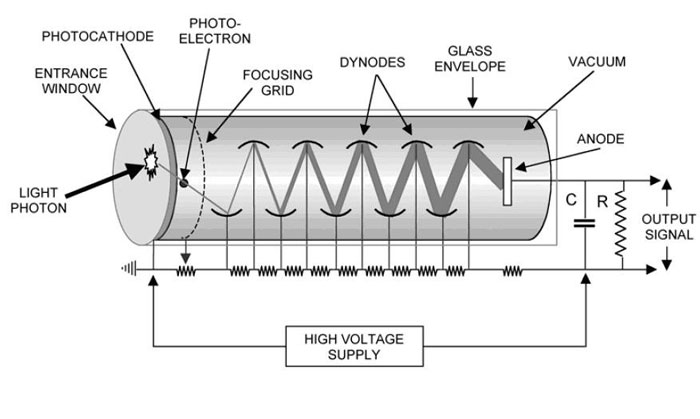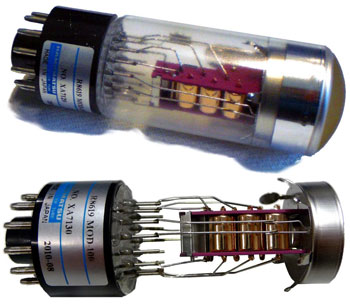Photomultiplier Tubes (PMT)
PMT is the technology state of the art at present. The photomultiplier is an extremely sensitive light detector providing a current output proportional to light intensity. Photomultipliers are used to measure any process which directly or indirectly emits light.
PMT is a well established technology. The operating principle is that – caused by the photoelectric effect – photons striking a photocathode at the entrance window of a PMT produce electrons, which are then accelerated by a high-voltage field and multiplied in number within a chain of dynodes by the process of secondary emission.
A continued R&D effort conducted by several European research institutes together with industry enabled the following milestones:
- The peak quantum efficiency of PMTs could
be raised from about 25% (2005) to an order of 35-45% (2016). - In the same time, the after-pulsing, one of the major problems in PMT technology, could be suppressed, for example, by a factor of about 40 down to a level of 0.01% for a preset threshold of ≥ 4 photo electrons (ph.e.).
Advanced R&D ideas for further substantial improvements do exist and are expected to use the potentialities for doubling of the photo-detection efficiency of the PMT technology. One major advantage of PMTs is that these can be produced in different sizes, starting from a few mm (as in multi-pixel PMTs) to half a meter in diameter (as those used in the Super-Kamiokande experiment).
One of the drawbacks of increasing the size of the PMT photocathode is the deterioration of the time resolution. KM3NeT, the neutrino telescope in the Mediterranean sea, has adopted a multi-PMT solution, where multiplexed PMTs improve angular uniformity of the response, increase photocathode coverage while keeping the time resolution excellent.
For the time being, PMTs are the only viable solution when large detection areas are required (for instance for large volume neutrino detectors).
On the other hand, the use of PMTs in cryogenic detectors is inconvenient and requires dedicated optimization. Moreover, some applications require reduced level of radioactivity. For installations including thousands of PMTs in large vessels, a high pressure resistance is an important parameter to reach for minimizing the risk of catastrophic implosions. It is also important to advance the currently developed architecture of PMT-arrays with a common read-out electronic. These developments will definitely expand the scope of application and thus will become important for industry.
PMT principle

PMT example

